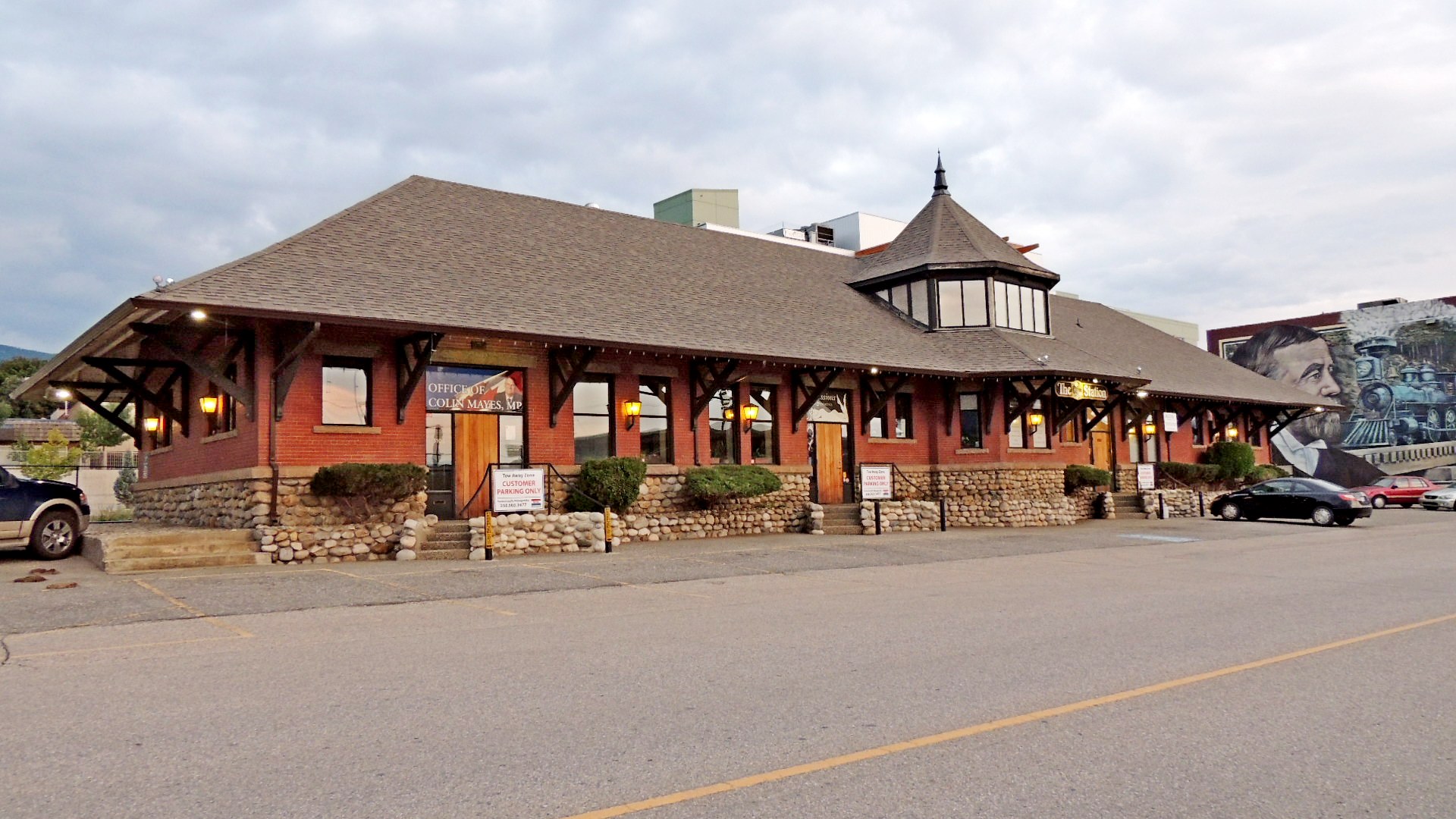|
 Vernon CPR Station - Vernon, BC Posted by:  T0SHEA T0SHEA
N 50° 15.874 W 119° 16.138
11U E 338291 N 5570510
Built in 1910 of brick with a fieldstone base, this station replaced an older wood station from 1891. Large and of "Swiss" or "Alpine" design, it was intended to promote tourism and settlement. By 1973 it ceased to be used as a railway station.
Waymark Code: WMMGDV
Location: British Columbia, Canada
Date Posted: 09/17/2014
Views: 4

Vernon CPR Station
DESCRIPTION OF HISTORIC PLACE
The Vernon Canadian Pacific Railway (CPR) Station is a one-and-one-half-storey rectangular red-brick train station in typical CPR railway design, characterized by an octagonal turret, hipped roof with gabled dormer, and wide overhanging eaves with large decorative brackets. It is located at the east end of 29th street at the base of the East Hill.
HERITAGE VALUE
The heritage value of the Vernon CPR Station lies in its association with the Canadian Pacific Railway and its role in the settlement and economic growth of Vernon and the Okanagan Valley. The construction, in 1891, of a branch line from the main CPR trans-Canada railway at Sicamous to Okanagan Landing led to an immediate spurt of growth, providing a conduit for settlers into the area and for agricultural products out of it. Vernon immediately became the commercial centre of the valley and the downtown business district moved east toward the railway. By 1910, Vernon was a prosperous community and the CPR was actively involved in attracting immigrants and tourists to the area. The 1891 station was replaced with a larger brick station with a fieldstone foundation and granite trim. The new station had a Dominion Express Company office at the south end, a central waiting room, telegraph office upstairs, and a baggage room.
The new station was part of a CPR programme in response to the rapid growth of competing railways such as the Canadian Northern, which completed its Edmonton station in 1905. The CPR built a succession of brick stations in 1907 in Saskatoon, South Edmonton, Medicine Hat and Lethbridge. They all had short polygonal towers and grey stone bases. A new station was built in Banff in 1910, with distinctive uncut stone at its base. The Vernon station, built the next year, included the decorative towers and dormers of the most recent CPR stations, as well as a stone base, this time in fieldstone. The fieldstone worked well to limit damage to the brick building from trolleys moving freight, and the decorative roof ornamentation gave the building a landmark character, both on the town side, which had the tower, and on the railway side, which featured the dormer. However, the upstairs was not designed for occupation.
As well as being noteworthy as an arrival point for settlers, the Vernon CPR Station was also the point of departure for troops in World War I and II. During both world wars, the Vernon Army Camp was an active training centre for thousands of troops who travelled on the CPR. The station was used for passenger service and for freight and mail service. By the 1960s, passenger service had ended and the station served as a freight office. By 1973, the CPR centralized freight services in Revelstoke and the Vernon station was leased to commercial businesses, including a restaurant. After a 1981 fire damaged the roof and interior, the CPR sold to a private business owner. The City of Vernon attempted to buy it, but was unsuccessful. The building now houses the Downtown Vernon Association, a law office, and additional offices upstairs.
The station is also significant for its architectural design. It was built according to a standard second class CPR station plan found throughout western Canada. The style, often referred to as 'alpine' or 'Swiss', was intended to give visitors a sense of the picturesque and promote tourism as well as settlement. Numerous architects including Edward Colonna, Edward and William Maxwell, and Fred Crossley, all of whom designed stations similar to Vernon’s station, practiced the style. The design details are considered variants of medieval revival styles. The Vernon station is a long rectangular building built of red brick. It has a hipped roof with a broad overhang. Large brackets connect the roof to the walls. A multi-sided turret with decorative finial surmounts the west elevation of the building, a gabled dormer decorated with plaster, and half-timbering is found on the east elevation. The foundation is in fieldstone. Granite is used for lintels and sills on the double-hung windows and there is a granite water table. The pink granite came from the Lefroy Quarry. T. E. Crowell was the contractor for the CPR Station. A garden was planned for the adjoining property, once the old station was removed.
From Historic Places Canada
Is the station/depot currently used for railroad purposes?: No

Is the station/depot open to the public?: Yes

If the station/depot is not being used for railroad purposes, what is it currently used for?:
Pub and restaurant and M.P.'s offices

What rail lines does/did the station/depot serve?: Canadian Pacific Railway

Station/Depot Web Site: [Web Link]

|
Visit Instructions:
Please post an original picture of the station/depot taken while you were there. Please also record how you came to be at this station/depot and any interesting information you learned about it while there.
Recent Visits/Logs:
| There are no logs for this waymark yet. |
|
|
|
|